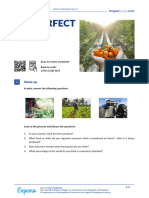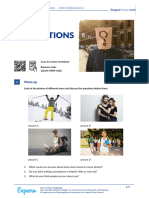Why Its Cool To Be Kind British English Student 1
Why Its Cool To Be Kind British English Student 1
Uploaded by
r i s uCopyright:
Available Formats
Why Its Cool To Be Kind British English Student 1
Why Its Cool To Be Kind British English Student 1
Uploaded by
r i s uOriginal Title
Copyright
Available Formats
Share this document
Did you find this document useful?
Is this content inappropriate?
Copyright:
Available Formats
Why Its Cool To Be Kind British English Student 1
Why Its Cool To Be Kind British English Student 1
Uploaded by
r i s uCopyright:
Available Formats
HEAAADERLOGORIGHT
ENGLISH FOR TEENAGERS · GENERAL ISSUES · UPPER-INTERMEDIATE (B2-C1)
WHY IT’S
COOL TO BE
KIND
QrrkoD Scan to review worksheet
Expemo code:
1AT1-77L9-VVDG
1 Warm up
In pairs or small groups, discuss the following questions.
a) Which, if any, of these emotions did you feel today?
sad happy angry mad glad
exhausted frustrated inspired resentful afraid
b) How do emotions connect with kindness?
c) What comes to mind when you think of the word ‘’kindness”?
FOOOOTERRIGHT Learn without forgetting! 1/10
Scan the QR at the top of Page 1 to review the lesson flashcards with Expemo.
© Linguahouse.com. Photocopiable and licensed for use in Dalila Gogia's lessons.
HEAAADERLOGORIGHT
UPPER-INTERMEDIATE (B2-C1)
WHY IT’S COOL TO BE KIND
2 Focus on vocabulary
Part A: Match the following vocabulary with their definitions.
1. cultivation (n) a. part of the essential nature of something
2. insensitive (adj.) b. straightforward or direct in speech or manner.
3. blunt (adj.) c. ability to show the good judgement of something
4. inherent (adj.) d. an act of kindness or generosity
5. alleviate (v) e. reduce the severity of something
6. altruism (n) f. caring about the needs of others, even without personal gain
7. contagious (adj.) g. deliberately improving something through effort
8. good deed (phr.) h. able to spread to others
9. discernment (n) i. not caring about the feelings of others
Part B: Complete the gaps with the vocabulary above.
1. Members of the Scouts Organisation have to do a every day.
2. I say I am honest and direct but some people describe me as .
3. He showed great when choosing which college to attend.
4. The painkiller helped his headache.
5. The of wealth is a goal for many people.
6. The young girl’s laugh was . She put everyone in a good mood.
7. Voluntarily donating blood is an example of .
8. Risking your money is an part of all gambling.
9. He was really after I lost my job. He just told me to stop crying
and get over it.
FOOOOTERLEFT Learn without forgetting! 2/10
Scan the QR at the top of Page 1 to review the lesson flashcards with Expemo.
© Linguahouse.com. Photocopiable and licensed for use in Dalila Gogia's lessons.
HEAAADERLOGORIGHT
UPPER-INTERMEDIATE (B2-C1)
WHY IT’S COOL TO BE KIND
3 Reading for gist
Part A: You are going to do a reading about kindness. One of the sub-headings is: ‘’The surprising
benefits of kindness”. Can you predict any of the benefits the article will describe?
Part B: Now, read the text and add the correct heading to the paragraphs (A-J). There is one which is
not needed.
• Kindness starts with being kind to yourself
• The ripple effect of kindness
• We need kindness to survive
• A different kind of to-do list
• What is kindness?
• Kindness in social media
• Kindness needs compassion
• The surprising benefits of kindness
• Kindness can cost the giver
• Kindness can be complex
• Is empathy the same as kindness?
FOOOOTERRIGHT Learn without forgetting! 3/10
Scan the QR at the top of Page 1 to review the lesson flashcards with Expemo.
© Linguahouse.com. Photocopiable and licensed for use in Dalila Gogia's lessons.
HEAAADERLOGORIGHT
UPPER-INTERMEDIATE (B2-C1)
WHY IT’S COOL TO BE KIND
Kindness
A big-small behaviour
1
A.
Kindness is showing consideration to others, as opposed to being insensitive, harmful or uncaring. All beings,
humans and animals, appreciate kindness.
2
B.
Kindness is a quality that seems inherent in human beings. As social animals, we need others’ kindness to survive.
3
C.
What does it mean to be kind? If someone asks for something that might be harmful to them, for instance, an
alcoholic asking for a drink, is it kind to give it to them? Which economic policies are the kindest? When does
kindness mean pushing past one’s own limits?
4
D.
Houston Kraft, who co-founded CharacterStrong, a program that teaches social and emotional skills to students
says: ‘’I hear people say, "Why aren’t people more kind to each other? It doesn’t cost you anything." And I’m
like, "No, it definitely does." "If I don’t spend time first identifying what people are going through, what they’re
navigating, what they actually need, then my kindness is going to typically serve me more than it does the person
on the far side. Probably the biggest cost for most people is comfort.”
5
E.
The cultivation of compassion, empathy, and discernment will enhance kindness. Everyone has challenges, many
hidden from sight.
6
F.
One must first learn to be kind to oneself and practise self-compassion. When we are unkind towards ourselves,
it is very difficult to be kind to another. Be kind to yourself when you make a mistake. Not doing so may lead
to others becoming the target of the anger, frustration or disappointment that we really feel about ourselves. Dr
James Kirby, a psychology lecturer at The University of Queensland says: "If I am being kind towards myself, the
same regions light up if I’m receiving kindness from another person or giving kindness to another person. That’s
why we tell people, when you have a setback or difficulty, what’s the tone of your self-talk like? Do you talk to
yourself in an aggressive, matter-of-fact, blunt way, or can you speak to yourself in a friendlier way?
7
G.
Kindness can also cause a kind of ’ripple effect’. A 2018 study of employees at a Spanish company found that
workers who received acts of kindness became happier and the effects of the altruism were contagious. However,
those who delivered the acts of kindness benefitted even more.
8
H.
According to research from Emory University, when you are kind to another person, your brain’s pleasure and
reward centres light up, as if you were the recipient of the good deed - not the giver. It also releases two chemicals,
oxytocin, which reduces inflammation and can protect the heart by lowering blood pressure, and serotonin. ‘’It’s
not uncommon to experience a ’feel-good rush’ after you’ve been kind to another person,” says Dr Kirby.
FOOOOTERLEFT Learn without forgetting! 4/10
Scan the QR at the top of Page 1 to review the lesson flashcards with Expemo.
© Linguahouse.com. Photocopiable and licensed for use in Dalila Gogia's lessons.
HEAAADERLOGORIGHT
UPPER-INTERMEDIATE (B2-C1)
WHY IT’S COOL TO BE KIND
9
I.
Jamil Zaki, PhD, an associate professor of psychology at Stanford University, says that empathy alone can lead us to
feel bad for people who are suffering and still do nothing to alleviate that suffering. He says empathy encapsulates
sharing, thinking, and caring. Sharing means asking yourself: "Do I know what you’re feeling?" Thinking is more
of the cognitive form of empathy. "How do I imagine myself in your experience?" Caring is the active component.
That’s where kindness comes in.
10
J.
Houston Kraft suggests that instead of writing only a ’to-do’ list, we should also focus on how we want to be. So
we should also write a ’to- be list’ which focuses on the questions: ‘’Who do I want to give my kindness to today?
What do they need today?”
Sources: UNESCO, Health Harvard, ABC.net
4 Listening: discussion
Watch the following video from Houston Kraft. He is a speaker and author of ‘’Deep Kindness”. Then
discuss the following questions.
1. What do you think about what he said?
2. Are we too self-obsessed?
3. Is it difficult to be kind sometimes? Why/why not?
5 Language point: adjectives with ing and ed
Part A: There are many common adjectives which are used to describe emotions and feelings which
can end in either ing or ed:
FOOOOTERRIGHT Learn without forgetting! 5/10
Scan the QR at the top of Page 1 to review the lesson flashcards with Expemo.
© Linguahouse.com. Photocopiable and licensed for use in Dalila Gogia's lessons.
HEAAADERLOGORIGHT
UPPER-INTERMEDIATE (B2-C1)
WHY IT’S COOL TO BE KIND
• Adjectives that end in -ed are used to describe how people feel, eg: I’m interested in the
movie.
• Adjectives that end in -ing are used to describe things and situations, eg: The movie is
interesting.
-ed -ing
annoyed annoying
bored boring
confused confusing
depressed depressing
excited exciting
frustrated frustrating
frightened frightening
satisfied satisfying
shocked shocking
FOOOOTERLEFT Learn without forgetting! 6/10
Scan the QR at the top of Page 1 to review the lesson flashcards with Expemo.
© Linguahouse.com. Photocopiable and licensed for use in Dalila Gogia's lessons.
HEAAADERLOGORIGHT
UPPER-INTERMEDIATE (B2-C1)
WHY IT’S COOL TO BE KIND
• Usually the ‘thing’ ends in ing. So the thing is interesting, boring, amazing etc.
The book is interesting.
The person is interesting.
The situation is interesting
• All of these are nouns or things.
• So remember, the thING is interestING, borING, amazING etc.
• But, note, in some cases a person can be like a thing. Look at these sentences:
Tom is so bored at school. → Tom is not interested in
school. It does not hold his interest.
Tom is so boring at school. → Tom is the reason other
people feel bored. He does not hold their interest.
• The feelings of the person usually end in ED.
• So, you can imagine a person named Fred. FrED feels interestED, borED, amazED etc.
FOOOOTERRIGHT Learn without forgetting! 7/10
Scan the QR at the top of Page 1 to review the lesson flashcards with Expemo.
© Linguahouse.com. Photocopiable and licensed for use in Dalila Gogia's lessons.
HEAAADERLOGORIGHT
UPPER-INTERMEDIATE (B2-C1)
WHY IT’S COOL TO BE KIND
Part B: Circle the correct option in each sentence.
1. You look really bored / boring. Why don’t you go find something to do?
2. I got the job! I can’t believe it, I am so excited / exciting!
3. My little brother is always making noise. He’s so annoyed / annoying.
4. The instructions were so confused / confusing that we accidentally put the doors on backwards..
5. Her colleagues were really surprised / surprising that she didn’t get fired.
6. I read such an interested / interesting article the other day.
7. My dogs get really frightened / frightening when there are fireworks.
8. His behaviour in class was really disappointed / disappointing.
6 Roleplay activity
Look at the wheel of emotions below. In pairs, you are going to each select an emotion and then do
the dialogue on page nine using that emotion. Your teacher will give you more instructions.
FOOOOTERLEFT Learn without forgetting! 8/10
Scan the QR at the top of Page 1 to review the lesson flashcards with Expemo.
© Linguahouse.com. Photocopiable and licensed for use in Dalila Gogia's lessons.
HEAAADERLOGORIGHT
UPPER-INTERMEDIATE (B2-C1)
WHY IT’S COOL TO BE KIND
Person A: Hello, welcome to Burger Yum Yum. What would you like to order?
Person B: I’d like a Burger Yum Yum special, please.
Person A: Okay, would you like fries and a drink to go with that?
Person B: No, thank you.
Person A: Are you sure? The burger is $7, but if you get the menu it will be $7.50.
Person B: I’m not that hungry.
Person A: Okay, no problem.
Person B: Oh wait, can I please have ketchup instead of mayonnaise on the burger?
Person A: Sure, that will be $7.50.
Person B: But, I thought the burger was $7.00.
Person A: It’s 50 cents extra for changes.
Person B: Okay well in that case... actually, never mind. Here you go.
Person A: Thank you, and have a nice day.
FOOOOTERRIGHT Learn without forgetting! 9/10
Scan the QR at the top of Page 1 to review the lesson flashcards with Expemo.
© Linguahouse.com. Photocopiable and licensed for use in Dalila Gogia's lessons.
HEAAADERLOGORIGHT
UPPER-INTERMEDIATE (B2-C1)
WHY IT’S COOL TO BE KIND
7 Homework/extension task
Brainstorm some additional acts of kindness to add to the list of ideas. Choose one to do this week.
Ideas
1) Pick up one piece of rubbish from the ground and throw it in the bin.
2) Write a thank-you note to someone.
3) Hold the door open for someone.
4) Offer someone who needs a seat on public transport.
5) Make a donation to charity.
6) Give someone a compliment.
Other acts of kindness
7)
8)
9)
10)
11)
12)
FOOOOTERLEFT Learn without forgetting! 10/10
Scan the QR at the top of Page 1 to review the lesson flashcards with Expemo.
© Linguahouse.com. Photocopiable and licensed for use in Dalila Gogia's lessons.
You might also like
- Losing Everyday Objects American English StudentDocument5 pagesLosing Everyday Objects American English StudentloveenglishcourseNo ratings yet
- Euro Politicians Get Sent To Disneyland British English StudentDocument9 pagesEuro Politicians Get Sent To Disneyland British English StudentKarolina KudelskaNo ratings yet
- The Perfect Farm British English StudentDocument6 pagesThe Perfect Farm British English StudentSaraNo ratings yet
- Company and Job - PDF+Document8 pagesCompany and Job - PDF+parapuro wearNo ratings yet
- Good To Great by Jim Collins Book SummaryDocument8 pagesGood To Great by Jim Collins Book SummaryKala KingNo ratings yet
- Criminal Law 1 Finals Case Digests (Bitor, Jhoanna Paula N. 2017-0575)Document80 pagesCriminal Law 1 Finals Case Digests (Bitor, Jhoanna Paula N. 2017-0575)Paula Bitor100% (1)
- Why Its Cool To Be Kind British English StudentDocument10 pagesWhy Its Cool To Be Kind British English StudentEllenNo ratings yet
- Cyberbullying British English StudentDocument7 pagesCyberbullying British English StudentGracia ManzanoNo ratings yet
- Following Your Intuition British English TeacherDocument12 pagesFollowing Your Intuition British English Teacherregaka2060No ratings yet
- Visiting The United States of America California British English TeacherDocument13 pagesVisiting The United States of America California British English TeacherTamta KoshkadzeNo ratings yet
- Making Assumptions British English TeacherDocument17 pagesMaking Assumptions British English TeacherBeatriz AlencarNo ratings yet
- Being A Ceo American English TeacherDocument9 pagesBeing A Ceo American English Teacherf98ykjhtm8No ratings yet
- A Room Qith A View STUDENTSDocument9 pagesA Room Qith A View STUDENTSIraia FNo ratings yet
- Robot Comedy British English TeacherDocument11 pagesRobot Comedy British English TeacherTamta Koshkadze100% (1)
- Mixed Signals For Outsourcing British English StudentDocument7 pagesMixed Signals For Outsourcing British English Studentreseau.bpkNo ratings yet
- Stress TimebombDocument4 pagesStress TimebombLacassiapeiaNo ratings yet
- Nepotism American English StudentDocument4 pagesNepotism American English StudentLucas FonsecaNo ratings yet
- Computers and The Internet PDFDocument4 pagesComputers and The Internet PDFKally TeelahtiNo ratings yet
- Saving The Rainforest - KeyDocument9 pagesSaving The Rainforest - KeyJoanna B.100% (1)
- Unintended ConsequencesDocument6 pagesUnintended Consequencesfigenergurbuz1980100% (1)
- Present Perfect 1 British English Teacher Ver2 BWDocument4 pagesPresent Perfect 1 British English Teacher Ver2 BWDiana Mireya Cuellar SanchezNo ratings yet
- A Room TeacherDocument14 pagesA Room TeacherIraia FNo ratings yet
- The Future of Work British English Student Ver2Document3 pagesThe Future of Work British English Student Ver2Bastien Boulnois100% (1)
- Office Speak (Teacher Copy)Document5 pagesOffice Speak (Teacher Copy)universe english schoolNo ratings yet
- The MediaDocument5 pagesThe MediaХристина ПартикаNo ratings yet
- The Job Interview American English TeacherDocument8 pagesThe Job Interview American English TeacherGiannina MussiNo ratings yet
- Changing Careers British English Student Ver2Document3 pagesChanging Careers British English Student Ver2Milica KocovicNo ratings yet
- The Career Ladder British English StudentDocument6 pagesThe Career Ladder British English Studentsimona chabreckovaNo ratings yet
- Insta Green British English StudentDocument8 pagesInsta Green British English StudentCarolFernandesNo ratings yet
- Office Equipment and SuppliesDocument4 pagesOffice Equipment and Suppliesjacqui1322No ratings yet
- Bad Meetings American English StudentDocument3 pagesBad Meetings American English StudentLiezl NaingNo ratings yet
- Im Not Sure British English TeacherDocument15 pagesIm Not Sure British English TeachermixxNo ratings yet
- The e CommerceDocument5 pagesThe e CommerceMalcom ClosseNo ratings yet
- DjokovicDocument11 pagesDjokovicЛили ГаутNo ratings yet
- The Hackers From The North British English TeacherDocument12 pagesThe Hackers From The North British English TeacherHolly GillNo ratings yet
- Flying British English TeacherDocument7 pagesFlying British English TeacherAlyona RozumetsNo ratings yet
- Comparing Brands American English TeacherDocument12 pagesComparing Brands American English TeacherLeonardo FreiresNo ratings yet
- ActivismDocument14 pagesActivismInglês com IvanNo ratings yet
- Humor American English Student Ver2Document4 pagesHumor American English Student Ver2Vitor SouzaNo ratings yet
- Whats So Funny British English TeacherDocument12 pagesWhats So Funny British English TeacherNataša PetrovićNo ratings yet
- Travel British English TeacherDocument4 pagesTravel British English TeacherAndreea MihalacheNo ratings yet
- Silent Ambition British English StudentDocument3 pagesSilent Ambition British English StudentAgnieszka100% (1)
- Expenses British English StudentDocument12 pagesExpenses British English StudentCarla MacchiNo ratings yet
- Gamestop Shares Shocker British English Teacher BWDocument9 pagesGamestop Shares Shocker British English Teacher BWSanny WendyNo ratings yet
- Netflix or The Movie Theater American English StudentDocument9 pagesNetflix or The Movie Theater American English StudentalunostodosNo ratings yet
- Meps Approves Worlds First Comprehensive Ai Law American English StudentDocument7 pagesMeps Approves Worlds First Comprehensive Ai Law American English Studentf98ykjhtm8No ratings yet
- A City Tour British English TeacherDocument10 pagesA City Tour British English TeacherSorana PaleuNo ratings yet
- Sharing Viewpoints - WorksheetDocument3 pagesSharing Viewpoints - WorksheetMuhammad RiwandiNo ratings yet
- Marketing Strategies: of Ine vs. Online MarketingDocument3 pagesMarketing Strategies: of Ine vs. Online MarketingIryna DribkoNo ratings yet
- Pre Intermediate English Review 2 Units 13 23 American English TeacherDocument11 pagesPre Intermediate English Review 2 Units 13 23 American English TeacherCarolinaNo ratings yet
- Hello Im On The Plane British English TeacherDocument10 pagesHello Im On The Plane British English Teacherwlimaoteacher5No ratings yet
- Visiting South Africa British English StudentDocument10 pagesVisiting South Africa British English StudentOlena SeniukNo ratings yet
- Phrasal Verbs 1 British English TeacherDocument7 pagesPhrasal Verbs 1 British English Teachersimona chabreckovaNo ratings yet
- 37 Well-Being-British-English-StudentDocument7 pages37 Well-Being-British-English-StudentBIANCA SILVA(116470)-FNo ratings yet
- Think PinkDocument12 pagesThink PinkEmilia OlszewskaNo ratings yet
- Talking Trees British English TeacherDocument12 pagesTalking Trees British English TeacherВладислав ОлександровичNo ratings yet
- Cyber CrimeDocument4 pagesCyber CrimeHamdiMidou100% (1)
- The Herring Girls American English StudentDocument8 pagesThe Herring Girls American English StudentLetícia BritoNo ratings yet
- Innovation and Product Development British English Teacher Ver2Document4 pagesInnovation and Product Development British English Teacher Ver2kitmengNo ratings yet
- Gaming American English StudentDocument9 pagesGaming American English StudentmajulixzNo ratings yet
- Why Its Cool To Be Kind British English TeacherDocument14 pagesWhy Its Cool To Be Kind British English TeacherMaria Dolores RodriguezNo ratings yet
- Why Its Cool To Be Kind British English TeacherDocument13 pagesWhy Its Cool To Be Kind British English TeacherGaby DayanNo ratings yet
- AnnotationDocument10 pagesAnnotationChristine Jane OrculloNo ratings yet
- WRT 1020 Cause and Effect Paper - SmokingDocument10 pagesWRT 1020 Cause and Effect Paper - Smokingapi-248441390No ratings yet
- Psychosexual Development (Freud)Document5 pagesPsychosexual Development (Freud)Karan MirchandaniNo ratings yet
- Annis v. Law - Superior Court of California, Monterey CountyDocument22 pagesAnnis v. Law - Superior Court of California, Monterey CountyPaul Charles D.100% (1)
- Pauline Garnier-Crussard #37, South Street, Waltham, M.A.Document1 pagePauline Garnier-Crussard #37, South Street, Waltham, M.A.polyn20No ratings yet
- QuestionaireDocument6 pagesQuestionairejmar100% (1)
- Thesis JeugddelinquentieDocument4 pagesThesis Jeugddelinquentieafknikfgd100% (2)
- Introduction Plus Flyer1Document18 pagesIntroduction Plus Flyer1Yeni YuniawatiNo ratings yet
- Lesson 1 PDFDocument9 pagesLesson 1 PDFCara Jane AntipordaNo ratings yet
- Ams Handbook 2015-16Document45 pagesAms Handbook 2015-16pdallevaNo ratings yet
- Chapter 1 Notes - PsychologyDocument42 pagesChapter 1 Notes - PsychologyChristian Parker0% (1)
- Ethics in International Business: N20283064 Nabeel N Sabooni Exe Mba (Ibm)Document6 pagesEthics in International Business: N20283064 Nabeel N Sabooni Exe Mba (Ibm)Nabeel SabooniNo ratings yet
- Parole Board of Canada's Report On Daon Gordon GlasgowDocument5 pagesParole Board of Canada's Report On Daon Gordon GlasgowCTV Vancouver100% (1)
- Press ReleaseDocument4 pagesPress ReleaseWilfred Gbe AlibeaNo ratings yet
- The Controversies of Michael JacksonDocument2 pagesThe Controversies of Michael JacksonDaisuke WongNo ratings yet
- Banakhat in Gujarati PDFDocument5 pagesBanakhat in Gujarati PDFVipul ChaudharyNo ratings yet
- Contract Law Assignment - FY LLBDocument2 pagesContract Law Assignment - FY LLBvimalNo ratings yet
- Cross Cultural NegotiationsDocument2 pagesCross Cultural Negotiationsmalu19711100% (1)
- K2Document6 pagesK2BERSERK3536No ratings yet
- Tagalog Report KoDocument8 pagesTagalog Report KoBeverly TaniongonNo ratings yet
- The Importance of Being ErnestDocument94 pagesThe Importance of Being ErnestSerian Mavi100% (3)
- The Onion 1998: Nobody Believes This ShitDocument2 pagesThe Onion 1998: Nobody Believes This ShitivstinivsNo ratings yet
- Estaff - News PaperDocument12 pagesEstaff - News PaperLindsay JurieNo ratings yet
- I - LL Make You An Offer You Can - T RefuseDocument9 pagesI - LL Make You An Offer You Can - T RefuseWarren BuffetNo ratings yet
- Rappler Documentary NewsDocument1 pageRappler Documentary NewsSheenlou Eian BartolomeNo ratings yet
- Corporate Governance: Suggested Answers and Examiner's CommentsDocument19 pagesCorporate Governance: Suggested Answers and Examiner's CommentsZahid UsmanNo ratings yet
- Group 1 - Section E - Terror at TajDocument11 pagesGroup 1 - Section E - Terror at TajAnisha GoyalNo ratings yet
- Best Manager ReportDocument6 pagesBest Manager ReportShilpa Reddy50% (2)

























































































